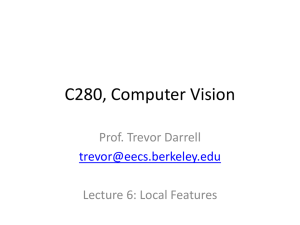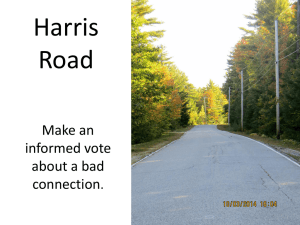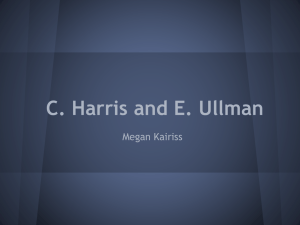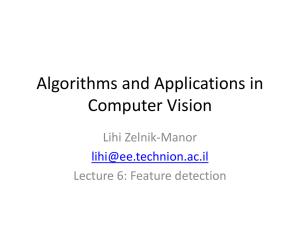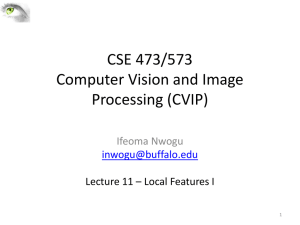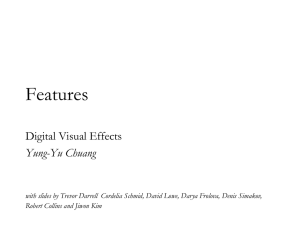here - ENS de Lyon
advertisement
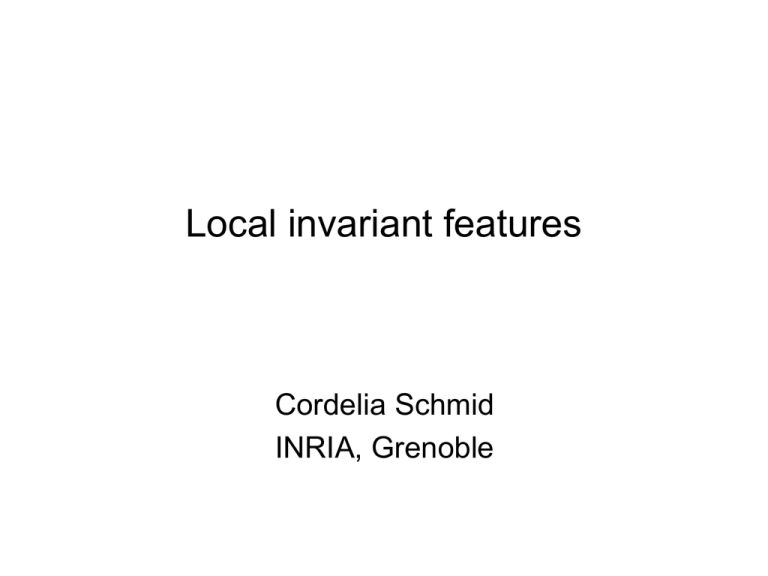
Local invariant features
Cordelia Schmid
INRIA, Grenoble
Local features
()
local descriptor
Several / many local descriptors per image
Robust to occlusion/clutter + no object segmentation required
Photometric : distinctive
Invariant : to image transformations + illumination changes
Local features: interest points
Local features: Contours/segments
Local features: segmentation
Application: Matching
Find corresponding locations in the image
Illustration – Matching
Interest points extracted with Harris detector (~ 500 points)
Illustration
Matching
– Matching
Interest points matched based on cross-correlation (188 pairs)
Illustration
Global constraints
– Matching
Global constraint - Robust estimation of the fundamental matrix
99 inliers
89 outliers
Application: Panorama stitching
Application: Instance-level recognition
Search for particular objects and scenes in large databases
…
Difficulties
Finding the object despite possibly large changes in
scale, viewpoint, lighting and partial occlusion
requires invariant description
Scale
Viewpoint
Lighting
Occlusion
Difficulties
• Very large images collection need for efficient indexing
– Flickr has 2 billion photographs, more than 1 million added daily
– Facebook has 15 billion images (~27 million added daily)
– Large personal collections
– Video collections, i.e., YouTube
Applications
Search photos on the web for particular places
Find these landmarks
...in these images and 1M more
Applications
• Take a picture of a product or advertisement
find relevant information on the web
[Pixee – Milpix]
Applications
• Finding stolen/missing objects in a large collection
…
Applications
• Copy detection for images and videos
Query video
Search in 200h of video
Local features - history
• Line segments [Lowe’87, Ayache’90]
• Interest points & cross correlation [Z. Zhang et al. 95]
• Rotation invariance with differential invariants [Schmid&Mohr’96]
• Scale & affine invariant detectors [Lindeberg’98, Lowe’99,
Tuytelaars&VanGool’00, Mikolajczyk&Schmid’02, Matas et al.’02]
• Dense detectors and descriptors [Leung&Malik’99, Fei-Fei&
Perona’05, Lazebnik et al.’06]
• Contour and region (segmentation) descriptors [Shotton et al.’05,
Opelt et al.’06, Ferrari et al.’06, Leordeanu et al.’07]
Example for line segments
images 600 x 600
Example for line segments
248 / 212 line segments extracted
Matched line segments
89 matched line segments - 100% correct
3D reconstruction of line segments
Problems of line segments
• Often only partial extraction
– Line segments broken into parts
– Missing parts
• Information not very discriminative
– 1D information
– Similar for many segments
• Potential solutions
– Pairs and triplets of segments
– Interest points
Overview
• Harris interest points
•
Comparing interest points
• Scale & affine invariant interest points
• Evaluation and comparison of different detectors
• Region descriptors and their performance
Harris detector [Harris & Stephens’88]
Based on the idea of auto-correlation
Important difference in all directions => interest point
Images
• We can think of an image as a function, f, from
R2 to R:
– f( x, y ) gives the intensity at position ( x, y )
– the image is defined over a rectangle with a finite range
• A color image is just three functions pasted together. We
can write this as a “vector-valued” function:
r ( x, y )
f ( x, y ) g ( x, y )
b( x, y )
Digital images
• In computer vision we operate on digital images:
– Sample the 2D space on a regular grid
– Quantize each sample (round to nearest integer)
• The image can now be represented as a matrix of integer
values (pixels)
Harris detector
Auto-correlation function for a point ( x, y ) and a shift (x, y )
2
(
I
(
x
,
y
)
I
(
x
x
,
y
y
))
k k
k
k
a( x, y)
( xk , yk )W ( x , y )
(x, y)
W
Harris detector
Auto-correlation function for a point ( x, y ) and a shift (x, y )
2
(
I
(
x
,
y
)
I
(
x
x
,
y
y
))
k k
k
k
a( x, y)
( xk , yk )W ( x , y )
(x, y)
W
{
a ( x, y )
small in all directions
→ uniform region
large in one directions → contour
large in all directions → interest point
Harris detector
Harris detector
Discret shifts are avoided based on the auto-correlation matrix
with first order approximation
x
I ( xk x, yk y ) I ( xk , yk ) ( I x ( xk , yk ) I y ( xk , yk ))
y
2
(
I
(
x
,
y
)
I
(
x
x
,
y
y
))
k k
k
k
a( x, y)
( xk , yk )W ( x , y )
x
I x ( xk , yk ) I y ( xk , yk )
( x , y )W
y
k
k
2
Harris detector
( I x ( xk , yk )) 2
x y ( xk , yk )W
I x ( xk , yk ) I y ( xk , yk )
( xk
, y k )W
I ( x , y ) I ( x , y ) x
( I ( x , y )) y
x
( xk , yk )W
k
k
y
k
2
( xk , yk )W
y
k
Auto-correlation matrix
the sum can be smoothed with a Gaussian
I x2
x y G
I x I y
k
I x I y x
2
I y y
k
Harris detector
• Auto-correlation matrix
I x2
G
I x I y
IxI y
2
I y
– captures the structure of the local neighborhood
– measure based on eigenvalues of this matrix
• 2 strong eigenvalues => interest point
• 1 strong eigenvalue => contour
=> uniform region
• 0 eigenvalue
Interpreting the eigenvalues
Classification of image points using eigenvalues of M:
2
“Edge”
2 >> 1
“Corner”
1 and 2 are large,
1 ~ 2 ;
E increases in all
directions
1 and 2 are small;
E is almost constant
in all directions
“Flat”
region
“Edge”
1 >> 2
1
Corner response function
R det(M ) trace(M ) 12 (1 2 )
2
α: constant (0.04 to 0.06)
“Edge”
R<0
2
“Corner”
R>0
|R| small
“Flat”
region
“Edge”
R<0
Harris detector
• Cornerness function
f det(a) k (trace(a))2 12 k (1 2 )2
Reduces the effect of a strong contour
• Interest point detection
– Treshold (absolut, relatif, number of corners)
– Local maxima
f thresh x, y 8 neighbourhood f ( x, y) f ( x, y)
Harris Detector: Steps
Harris Detector: Steps
Compute corner response R
Harris Detector: Steps
Find points with large corner response: R>threshold
Harris Detector: Steps
Take only the points of local maxima of R
Harris Detector: Steps
Harris detector: Summary of steps
1. Compute Gaussian derivatives at each pixel
2. Compute second moment matrix M in a Gaussian
window around each pixel
3. Compute corner response function R
4. Threshold R
5. Find local maxima of response function (non-maximum
suppression)
Harris - invariance to transformations
• Geometric transformations
– translation
– rotation
– similitude (rotation + scale change)
– affine (valide for local planar objects)
• Photometric transformations
– Affine intensity changes (I a I + b)
Harris Detector: Invariance Properties
• Rotation
Ellipse rotates but its shape (i.e. eigenvalues)
remains the same
Corner response R is invariant to image rotation
Harris Detector: Invariance Properties
• Affine intensity change
Only derivatives are used => invariance
to intensity shift I I + b
Intensity scale: I a I
R
R
threshold
x (image coordinate)
x (image coordinate)
Partially invariant to affine intensity change,
dependent on type of threshold
Harris Detector: Invariance Properties
• Scaling
Corner
All points will
be classified as
edges
Not invariant to scaling
Overview
• Harris interest points
•
Comparing interest points (SSD, ZNCC, Derivatives, SIFT)
• Scale & affine invariant interest points
• Evaluation and comparison of different detectors
• Region descriptors and their performance
Comparison of patches - SSD
Comparison of the intensities in the neighborhood of two interest points
( x2 , y2 )
( x1, y1 )
image 1
image 2
SSD : sum of square difference
N
1
( 2 N 1) 2
N
2
(
I
(
x
i
,
y
j
)
I
(
x
i
,
y
j
))
1 1
1
2
2
2
i N j N
Small difference values similar patches
Comparison of patches
N
SSD :
1
( 2 N 1) 2
N
2
(
I
(
x
i
,
y
j
)
I
(
x
i
,
y
j
))
1 1
1
2
2
2
i N j N
Invariance to photometric transformations?
Intensity changes (I I + b)
=> Normalizing with the mean of each patch
N
1
( 2 N 1) 2
N
2
((
I
(
x
i
,
y
j
)
m
)
(
I
(
x
i
,
y
j
)
m
))
1 1 1
1
2
2
2
2
i N j N
Intensity changes (I aI + b)
=> Normalizing with the mean and standard deviation of each patch
I1 ( x1 i, y1 j ) m1 I 2 ( x2 i, y2 j ) m2
1
( 2 N 1) 2
1
2
i N j N
N
N
2
Cross-correlation ZNCC
zero normalized SSD
I1 ( x1 i, y1 j ) m1 I 2 ( x2 i, y2 j ) m2
1
2
i N j N
N
1
( 2 N 1) 2
N
2
ZNCC: zero normalized cross correlation
I1 ( x1 i, y1 j ) m1 I 2 ( x2 i, y2 j ) m2
1
2
i N j N
N
1
( 2 N 1) 2
N
ZNCC values between -1 and 1, 1 when identical patches
in practice threshold around 0.5
Local descriptors
• Greyvalue derivatives
• Differential invariants [Koenderink’87]
– combinations of derivatives
• SIFT descriptor [Lowe’99]
Greyvalue derivatives: Image gradient
• The gradient of an image:
•
• The gradient points in the direction of most rapid increase in
intensity
• The gradient direction is given by
– how does this relate to the direction of the edge?
• The edge strength is given by the gradient magnitude
Source: Steve Seitz
Differentiation and convolution
• Recall, for 2D function, f(x,y):
f
f x , y f x, y
lim
0
x
• We could approximate this as
f f xn1 , y f xn , y
x
x
• Convolution with the filter
-1
1
Source: D. Forsyth, D. Lowe
Finite difference filters
• Other approximations of derivative filters exist:
Source: K. Grauman
Effects of noise
• Consider a single row or column of the image
– Plotting intensity as a function of position gives a signal
• Where is the edge?
Source: S. Seitz
Solution: smooth first
f
g
f*g
d
( f g)
dx
• To find edges, look for peaks in
d
( f g)
dx
Source: S. Seitz
Derivative theorem of convolution
• Differentiation is convolution, and convolution is
d
d
associative:
( f g) f g
dx
dx
• This saves us one operation:
f
d
g
dx
f
d
g
dx
Source: S. Seitz
Local descriptors
• Greyvalue derivatives
– Convolution with Gaussian derivatives
I ( x, y ) G ( ) L( x, y )
I ( x, y ) Gx ( ) Lx ( x, y )
I ( x, y ) * G ( ) L ( x, y )
y
y
v( x, y ) I ( x, y ) * Gxx ( ) Lxx ( x, y )
I ( x, y ) * G ( ) L ( x, y )
xy
xy
I ( x, y ) * Gyy ( ) Lyy ( x, y )
I ( x, y ) G ( )
G( x, y, ) I ( x x, y y)dxdy
x2 y 2
G ( x, y , )
exp(
)
2
2
2
2
1
Gaussian Kernel
• Gaussian filters have infinite support, but discrete filters
use finite kernels
• Rule of thumb: set filter half-width to about 3 σ
Local descriptors – rotation invariance
Invariance to image rotation : differential invariants [Koen87]
gradient magnitude
Laplacian
L
Lx Lx Ly Ly
Lxx Lx Lx 2 Lxy Lx Ly Lyy Lyy
L
L
xx
yy
Lxx Lxx 2 Lxy Lxy Lyy Lyy
Laplacian of Gaussian (LOG)
LOG Gxx ( ) Gyy ( )
SIFT descriptor [Lowe’99]
• Approach
–
–
–
–
–
8 orientations of the gradient
4x4 spatial grid
soft-assignment to spatial bins, dimension 128
normalization of the descriptor to norm one
comparison with Euclidean distance
3D histogram
image patch
gradient x
y
Local descriptors - rotation invariance
• Estimation of the dominant orientation
– extract gradient orientation
– histogram over gradient orientation
– peak in this histogram
0
• Rotate patch in dominant direction
2
Local descriptors – illumination change
• Robustness to illumination changes
in case of an affine transformation
I1 (x) aI 2 (x) b
• Normalization of the image patch with mean and variance
Invariance to scale changes
• Scale change between two images
• Scale factor s can be eliminated
• Support region for calculation!!
– In case of a convolution with Gaussian derivatives defined by
I ( x, y ) G ( )
G( x, y, ) I ( x x, y y)dxdy
x2 y 2
G ( x, y , )
exp(
)
2
2
2
2
1

